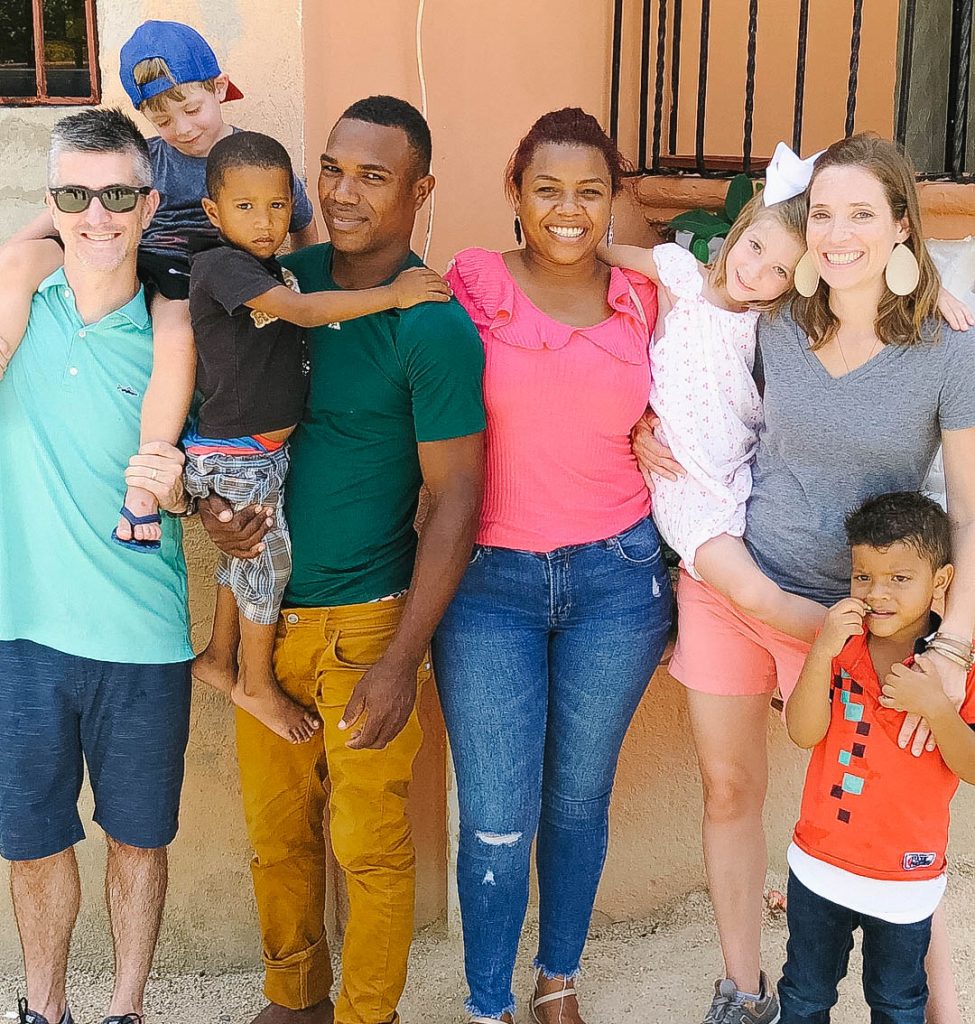
Have you ever been somewhere with your young child and suddenly he spots someone who looks or acts differently? Before you can steer him in a different direction, he starts pointing and (loudly) asking questions about the person. You freeze up, unsure of what to do or say. In today’s post we share how you and your children can graciously and lovingly handle these situations. I am also sharing about a non-profit doing wonderful things for children with disabilities in the Dominican Republic. A story that is sure to inspire!
Like so many things in parenting, it behooves us to prepare our children when it comes to interacting with people who may look or act differently due to disabilities, developmental delays or other issues. We can do that specifically by role playing different scenarios and generally by being intentional in creating a family culture of overwhelming love and acceptance for others. Today I’m honored to welcome Anna Harper to help us with both of these things.
Anna is a mother of two, foster parent, pediatric physical therapist, and Director of Development of PropelDR, a project of a larger non-profit, Mission Emanuel, that is dedicated to raising the quality of life of Dominicans with disabilities through education and mobility. Before we get to the “what to say” part of the post I wanted to ask her a little about this impactful organization.
Q: Anna, having been in the physical therapy world on the “mom side” I became aware (and quite inspired) by this annual trip that so many highly regarded Dallas Physical Therapists take to the Dominican Republic each year. Can you tell us more about it?
Over the past 10 years, ProperDR has delivered over 400 customs wheelchairs to children with the most extreme deformities who do not otherwise fit in a standard chair and who are not otherwise able to move around their environment or go to school. Last year, over 20 healthcare professionals including doctors, medical translators, PTs, OTs, and RNs went on this trip and over 1,000 Dominican healthcare providers and patients benefited from our lectures and wheelchair distributions. It is a priority that all of the work we do is alongside Dominican healthcare professionals in order to make sure there is lasting impact.

Q: That is amazing, Anna! Can you explain why a standard wheelchair doesn’t fit every child?
Custom wheelchairs are designed and built piece by piece based on each child’s needs to give them the ability to sit upright, which allows them to participate in school or really any out-of-the-house activity as well as promote optimal function (breathing, using their hands, etc.). For example, if a child tilts their head slightly to the left in order to be able to breath better, then that is taken into consideration in the wheelchair design. If a child has weakness on one side and not on the other then the right and left side of the chair will provide different support and stability and require different pieces of and parts. Each piece of the chair is ordered based on their individual needs so it is “custom made” for that child. Wheelchairs are made to “grow” with the child for up to five years so they are very expensive.

Q; What is the main goal of PropelDR and how can we help with this mission?
Typically we ship donated equipment to the Dominican Republic that families in Dallas have donated. But recently we have been working to partner with a wheelchair vendor from the Caribbean. Our goal this year is to walk through the process of evaluating, ordering and providing five wheelchairs with an only-Caribbean wheelchair team. That would mean that this is the FIRST time custom wheelchairs could be ordered and provided to those in the Dominican Republic without our help. It will cost $5,000 a chair (Like I said, those custom chairs are expensive!). So our goal is $25,000. Our biggest priority is a lasting impact and not a drop in then leave approach. It’s hard to explain how big of deal this is, but we are really excited! It would be a huge step in giving the Dominican disability population access to education, jobs, and the ability to participate in social activities. Anyone would like to get involved or donate can learn more here.

Q: Anna, anyone who knows you knows that you are an amazing mother who teaches your children to love graciously and selflessly. I am sure part of that comes from what you’ve seen and experienced working with children with severe disabilities. What’s a simple thing we can teach our children “to do” when they see someone who is differently or disabled?
A: My first rule for interacting with anyone that is “different” from ourselves is eye contact and a smile. It goes a REALLY long way and it always lets people know they are seen regardless of if they can or do respond (and we can’t put that expectation on them). In regards to my parenting style on talking about dis- or different abilities, we talk about how God makes everyone by His design for His purpose. Whether that be their ability to talk or not, one leg shorter than the other, eyes that are shaped differently, or how they move and get around.
Q: How can our children actually connect with a differently-abled or disabled child?
I think it’s helpful to find a way for kids (and adults!) to see that there are more similarities than differences. A high five, fist bump, or a hand shake goes a long way. Your child can even ask the parent/adult, “can I give your child a high five?” As with anyone, we always ask first if we are interacting with more than a smile and a “hi, how are you?”

Q: Any easy phrases or words we can give our children “to say”?
I would say my daughter’s favorite go-to to engaging anyone is an, “I like your _____.” She is great at finding something to compliment. It is okay to say “I like your wheelchair” or “I like your foot braces” or ” I like your necklace” or “I like your socks.”
Q: How do we avoid those cringe-inducing moments when our young child points out something (or asks loudly) about another child?
If it isn’t a compliment or a kind interaction, we teach that they can ask questions later unless the parent of the child gives them the go ahead. Of course, we can all be curious when we see something for the first time (including me!) but sometimes questions about differences can be hurtful. We save those for later and then talk about what questions are appropriate to ask in front of a person and consider if and why that could hurt someones feelings. Exposing our kids to differences early on is important. Even if you have to seek it out.
Additional advice from Lee: If you know you are going to be with a child who may garner questions or comments, prepare your children ahead of time and role play or practice things to say.

Q: What should we do when our children does say something hurtful or awkward in front of child who is disabled?
This is a hard one! Sometimes I try to redirect the conversation with, “we hope you have a great day!” or say “let’s have the conversation in the car.” Or, as I mentioned above, find something that is a genuine compliment like, “she has such pretty eyes!” I often try to let the parent know that I’m sorry that their child is the focus of our learning with a smile or I may even say, “we are learning what questions are kind to ask.”
Additional tip from Lee: most parents of children with disabilities are used to people commenting or giving looks to their child. Most are also extremely gracious. Be sure to acknowledge them as well with a smile or genuine word of kindness.
Q: How else can we talk to our children about how to be loving and gracious with differently abled children or children who may just look different because of a congenital or some other reason?
Wouldn’t it be a boring world if we were all of the same ability? No matter what the differences are, we all have something to learn and something that can be learned from us. From the child with the most severe seizure disorder who teaches us the importance of unconditional love and our need for community and a greater purpose, to a rambunctious child with poor personal space boundaries who would love to offer a hug to everyone he sees. What can we learn from them about ourselves? And let the beauty of differences teach us how to become better!
Anna, thank you for taking the time to answer our questions and for sharing about PropelDR.
Anna Harper is the Director of Development for PropelDR and serves on the Board of Mission Emanuel. She has been a pediatric physical therapist at Children’s Health in Dallas for most of the last 13 years, as well as working at The Rise School of Dallas, but currently spends the majority of her time at home with her daughter, Molly (8), and son, Davis (5). She and her husband, Andrew, have been married for 14 years and have been fostering infants from Dallas County over the last 2 years. She is passionate about people, seeing positive change happen, teaching her kids that everyone is valuable regardless of shape, language, color, or ability, and trusting that the Lord has her in ministry wherever she is currently standing. She spends her time rocking babies, trying to keep up with homework and laundry, enjoying time barefoot in the front yard with neighbors, and squeezing in time to work on PropelDR. Her front door is figuratively (and most of the time literally) always open!

Photos: PropelDR



I’m so thankful for this important post! I’d love to hear children’s book suggestions from you, Anna, and your readers on this topic so can continue the conversation with our kids via that medium!
Great idea! Let me ask Anna or maybe she will see this and respond!
This is such a great topic! I stumbled upon a Sesame Street book that did a great job at introducing this idea to young children called “We’re Different, We’re the Same”. In the book there are children (and muppets) of all nationalities and children with disabilities! Love your blog!
Thank you for this! I will look this book up!